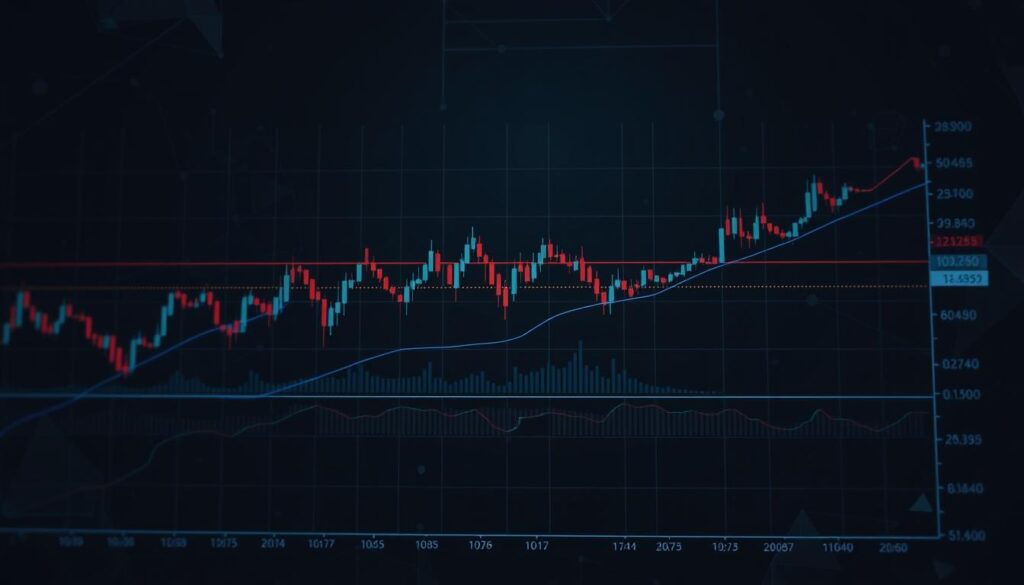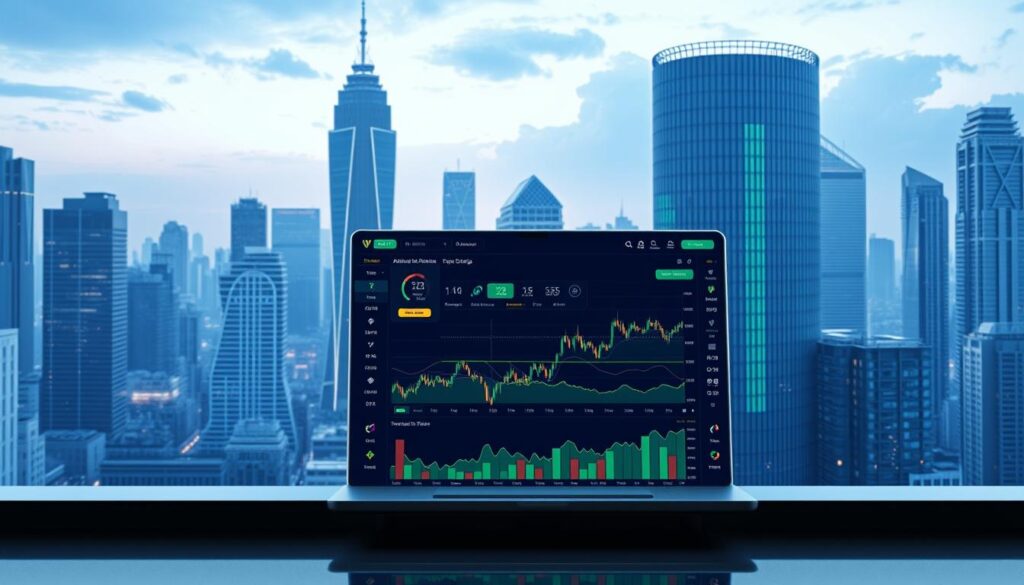Now Reading: Machine Learning Crypto Market Correlation: A Deep Dive
- 01
Machine Learning Crypto Market Correlation: A Deep Dive
Machine Learning Crypto Market Correlation: A Deep Dive

The digital asset trading landscape has undergone a massive transformation. Traditional analysis methods often fall short in this fast-paced environment. This is where advanced computational intelligence steps in to provide a clearer picture.
Understanding the complex relationships between different assets is now crucial for success. Sophisticated algorithms can process immense datasets to uncover hidden patterns. These insights are vital for navigating the market’s notorious volatility.
This analysis explores how modern technology is reshaping investment strategies. We will examine the evolution from basic statistics to powerful predictive models. The goal is to demonstrate how these tools generate actionable intelligence for traders.
The ability to forecast price movements accurately offers a significant advantage. In a space known for rapid shifts, precise predictions can protect capital and identify opportunities. This deep dive will cover various approaches, from classical algorithms to advanced architectures.
Key Takeaways
- Advanced computational methods are essential for analyzing modern digital asset markets.
- Sophisticated algorithms excel at identifying complex, non-obvious relationships between assets.
- Accurate forecasting provides a critical edge in a highly volatile trading environment.
- The field has evolved significantly from traditional statistical analysis.
- These powerful tools process vast amounts of data to uncover actionable insights.
- Understanding these correlations is key to developing robust trading strategies.
Introduction to Cryptocurrency Market Trends
The evolution of decentralized finance has created one of the most dynamic trading environments in history. Understanding these patterns is essential for navigating the complex world of digital assets.
Historical Price Fluctuations and Market Dynamics
Since Bitcoin’s launch in 2009, the sector has experienced dramatic cycles. Major bull runs have been followed by significant corrections. Bitcoin has reached values exceeding $60,000 before substantial declines.
This volatility distinguishes digital assets from traditional investments. Single-day swings of 10-20% are not uncommon. The lack of centralized oversight amplifies these price movements.
Social media sentiment and news events heavily influence cryptocurrency prices. Historical patterns show rapid appreciation periods followed by sharp corrections. These dynamics create both risks and opportunities.
The Growing Importance of Forecasting in Digital Assets
Accurate prediction has become critical as adoption expands. Major industries now accept Bitcoin for payments. This integration increases exposure to financial risk from sudden shifts.
The cryptocurrency market has matured into a $3.09 trillion ecosystem. With over 10,000 active digital currencies, sophisticated analysis is necessary. Forecasting helps investors navigate this complex landscape.
Understanding historical data provides insights into future price movements. As bitcoin prices continue to influence the broader cryptocurrency market, predictive tools become increasingly valuable for all participants.
Evolution of Financial Time Series Analysis in Crypto
Researchers initially approached digital asset forecasting with tools designed for more stable environments. They adapted classical models like ARIMA and exponential smoothing from traditional stock analysis.
These methods provided a useful starting point. However, they relied on assumptions that rarely held true for digital assets. Stationarity and linearity are cornerstones of classical financial time series analysis.
The dynamic nature of digital assets shattered these assumptions. Extreme volatility and sudden price shifts became common features. This created a significant challenge for traditional time series models.
Their inability to adapt to rapid changes was a major limitation. Techniques like vector autoregressive models struggled with non-linear patterns. This highlighted the need for a new analytical framework.
The unique characteristics of digital asset data forced a reevaluation. The 24/7 trading cycle and high-frequency fluctuations demanded more sophisticated tools. Lessons from conventional financial markets were valuable but required substantial modification.
This recognition marked a critical turning point in the analysis of digital asset financial time data. It paved the way for more adaptive and powerful modeling techniques.
Machine Learning Techniques in Cryptocurrency Forecasting
The quest for accurate predictions in digital assets spurred a significant methodological shift in analytical approaches. Early models like support vector machines and random forests marked a major step forward. They could find complex patterns without strict statistical rules.
These machine learning methods showed great promise. However, they had their own limits. Creating the right input features was a time-consuming task. They also struggled with the time-based nature of price data.
Transition from Traditional Statistical Models to Deep Learning
The introduction of neural networks was a game-changer. Recurrent architectures like LSTM and GRU were designed to handle sequences. This was perfect for analyzing historical price charts.
These advanced learning techniques could capture trends over time automatically. This moved analysis beyond basic feature engineering. The power of machine learning became fully apparent with these models.
Advantages over Conventional Forecasting Methods
The primary benefit is adaptability. These systems learn directly from raw data, including diverse sources like social sentiment. This leads to more robust cryptocurrency forecasting.
They handle high-dimensional data far better than old methods. For a deeper look at this evolution, explore our guide on advanced AI analysis. Despite challenges like high computational cost, the advantages of these machine learning techniques are clear for modern traders.
Machine learning crypto market correlation: Core Insights
At the heart of modern digital asset analysis lies the powerful ability to uncover hidden connections. Sophisticated computational systems excel at finding relationships that traditional methods miss entirely.
These advanced systems detect subtle patterns, like how one major digital asset often moves before others. They also find links between asset values and external factors like traditional stock indices.
Certain machine learning models are built specifically for this task. Ensemble methods, which combine several learning models, often provide the most reliable results. This approach boosts the accuracy of cryptocurrency price prediction.
The analysis goes beyond simple numbers. It captures complex links between trading volume, volatility, and public sentiment. This leads to a deeper, more nuanced price prediction.
Relationships between assets are not static. During times of high stress, correlations tend to become stronger. In calmer periods, these connections may weaken significantly.
Major digital assets like Bitcoin and Ethereum show different levels of price linkage. This depends on the overall trading environment and the timeframe being analyzed. Learning algorithms process multiple timeframes to understand both quick trades and long-term trends.
These insights have real-world uses. Traders build diversified portfolios and spot arbitrage chances. They also create hedging plans based on the predicted structure of asset relationships.
Deep Dive into Transformer-Based Approaches for Crypto Price Prediction
Unlike their predecessors, Transformer-based models process entire sequences of data simultaneously. This parallel approach is a radical departure from older recurrent architectures. It allows for a more comprehensive analysis of historical patterns.
These systems use self-attention mechanisms to weigh the importance of every past data point. This is crucial for understanding complex asset behavior. The technology captures relationships that simpler models often miss.
Modeling Long-Term vs. Short-Term Price Dependencies
A key innovation is the dual-branch framework. One branch specializes in long-term sequence modeling. It captures trends that unfold over weeks or months.
The other branch focuses on short-term prediction using high-frequency data. This branch analyzes fluctuations occurring within hours. Together, they provide a complete temporal picture.
Variants like Autoformer and Informer are designed specifically for financial time series. They have shown outstanding results on forecasting benchmarks. These learning models handle the unique volatility of digital assets effectively.
Empirical studies on top assets demonstrate consistent outperformance. These advanced neural networks beat traditional LSTM and RNN baselines. The advantage holds across various forecasting horizons.
The ability to model both immediate and distant influences is a major breakthrough. It addresses a core challenge in time series analysis. This leads to more robust and accurate forecasts for traders.
Evaluating Machine Learning Models in Algorithmic Trading
The true test of any predictive system lies in its ability to generate profits in live trading environments, not just statistical accuracy. A comprehensive study evaluated 41 different computational intelligence systems for Bitcoin price forecasting. This included 21 classification and 20 regression approaches.

The evaluation employed a rigorous three-phase methodology. Backtesting used historical data from 2013-2023. Forward testing analyzed unseen data from mid-2023. Real-world validation assessed practical trading performance.
| Machine Learning Metrics | Trading Performance Metrics | Practical Considerations |
|---|---|---|
| Mean Absolute Error (MAE) | Profit & Loss Percentage | Transaction Costs |
| Root Mean Squared Error (RMSE) | Sharpe Ratio | Slippage Impact |
| R-squared Value | Maximum Drawdown | Execution Delays |
Certain systems demonstrated superior performance across market conditions. Random Forest and Stochastic Gradient Descent showed consistent profitability. Their risk-adjusted returns outperformed other approaches.
The study revealed that statistical accuracy doesn’t always translate to trading success. Economic utility must be prioritized over pure forecasting precision. This ensures practical value in real trading scenarios.
Comparative Analysis of Deep Learning Models
Architectural design choices in neural systems significantly impact their effectiveness in volatile trading environments. This systematic comparative analysis evaluates different frameworks for digital asset forecasting.
Performance of LSTM and GRU in Volatile Markets
Early frameworks by Wu et al. (2018) utilized LSTM variants for Bitcoin prediction. These models captured temporal dependencies but struggled with overfitting in noisy conditions.
GRU-based architectures emerged with advantages in convergence speed and gradient handling. Awoke et al. found GRU slightly outperformed LSTM in both accuracy and training efficiency on real Bitcoin datasets.
Both architectures remain sensitive to hyperparameter settings. They face limitations with sequential processing bottlenecks and long-term dependency challenges.
Breakthroughs with Transformer Variants
Transformer-based approaches represent a fundamental shift from recurrent architectures. These systems process entire sequences simultaneously, overcoming sequential constraints.
Variants like Autoformer and Informer specifically designed for financial data show consistent outperformance. They excel at modeling both short-term fluctuations and long-term trends.
Ahire et al. (2024) demonstrated that transformer frameworks achieve superior accuracy across multiple digital assets. Their parallel processing capability provides significant advantages in model performance.
| Architecture Type | Training Efficiency | Long-Term Dependency Handling | Volatility Robustness |
|---|---|---|---|
| LSTM Networks | Moderate | Good | Sensitive |
| GRU Networks | High | Moderate | Sensitive |
| Transformer Variants | Variable | Excellent | High |
This comparative analysis reveals that while recurrent learning models improved forecasting, transformer architectures represent the current frontier. For detailed technical specifications, consult the comprehensive neural network research covering these advancements.
Integrating Technical Indicators for Enhanced Prediction
Sophisticated analytical systems gain significant predictive power by integrating established technical indicators into their frameworks. These tools translate raw, chaotic data into structured signals that reflect collective trader psychology and underlying momentum.
This approach provides a more nuanced view than price data alone. It helps models identify patterns that are invisible to the naked eye.

The methodology often employs rolling windows of varying durations—1, 7, 14, 21, and 28 days. This allows the system to capture patterns across different timescales, from intraday swings to monthly trends.
Utilizing Bollinger Bands, Moving Averages, and More
Common tools include the moving average, which smooths out price noise to reveal the core trend direction. Bollinger Bands build upon this by adding volatility-based channels around the average.
These bands help identify potential overbought or oversold conditions relative to recent closing price action. The Money Flow Index (MFI) offers another layer by combining price and volume data.
It measures the intensity of buying and selling pressure. Advanced indicators like the Parabolic SAR provide clear signals about momentum direction and potential reversals.
According to comprehensive research, models that incorporate this diverse set of features consistently achieve superior price prediction accuracy. The improvement is especially noticeable during periods of high volatility.
Sentiment Analysis and Its Impact on Cryptocurrency Prices
Public sentiment has emerged as a powerful driver behind the dramatic price swings characteristic of decentralized finance. Even minor news events or social statements can trigger significant price movements across digital assets.
Sentiment analysis techniques leverage artificial intelligence to process vast amounts of textual data from social platforms. These systems scan Twitter, Reddit, and specialized forums like StockTwits to gauge collective investor psychology.
Research demonstrates clear correlations between public mood and cryptocurrency price changes. Positive discussions often precede upward trends, while negative sentiment typically forecasts declines. Sohangir et al. (2023) found convolutional neural networks excelled at predicting investment sentiment from StockTwits data.
The integration of sentiment metrics with traditional technical indicators creates more robust forecasting models. This combination captures both quantitative data and qualitative psychological factors.
| Sentiment Analysis Challenge | Impact on Accuracy | Common Solutions |
|---|---|---|
| Bot-Generated Content | High distortion risk | Source credibility weighting |
| Sarcasm Detection | Moderate accuracy loss | Contextual analysis algorithms |
| Manipulation Attempts | Severe model corruption | Multi-source verification |
Real-time sentiment analysis systems provide continuous market mood updates. Traders use these insights to anticipate shifts in cryptocurrency price direction before major movements occur.
Despite challenges like content manipulation, artificial intelligence continues to refine these analytical approaches. The ability to decode public sentiment remains crucial for understanding digital asset volatility.
Comprehensive Review of Machine Learning Approaches in Financial Markets
Numerous studies have compared different artificial intelligence techniques for economic forecasting. This literature review synthesizes findings from dozens of research papers across financial domains.
The evolution spans from early support vector machines to sophisticated ensemble systems. Each machine learning approach offers unique advantages for different financial applications.
Role of Ensemble Methods and Random Forests
Random forest algorithms have demonstrated exceptional performance in financial prediction tasks. These systems aggregate predictions from multiple decision trees to reduce overfitting.

Comparative research shows ensemble learning methods consistently outperform individual models. Techniques like bagging, boosting, and stacking leverage complementary strengths.
| Algorithm Type | Prediction Accuracy | Computational Cost | Interpretability |
|---|---|---|---|
| Support Vector Machines | High | Moderate-High | Low |
| Random Forest | Very High | Moderate | Medium |
| Gradient Boosting | Highest | High | Low |
| Stacking Ensemble | Exceptional | Very High | Very Low |
Studies reveal that support vector approaches excel in classification tasks but require substantial computational resources. The random forest technique provides excellent generalization across various market conditions.
This comprehensive literature review identifies critical gaps in current research. Future work should address regime changes and extreme event handling.
Insights from International Conferences on Cryptocurrency Forecasting
The global research community has accelerated progress in forecasting through presentations at premier academic events. These gatherings bring together leading minds from both computer science and finance disciplines. They create a unique environment for sharing breakthrough discoveries.
Prestigious venues like NeurIPS, ICML, and AAAI have featured significant research on digital asset prediction. Specialized fintech conferences also contribute valuable insights. The collective knowledge shared at these events drives the field forward rapidly.
Presentations document the evolution from basic classifiers to sophisticated architectures designed for volatile assets. A key trend is the growing adoption of attention mechanisms. Researchers also emphasize multi-modal data integration and model robustness.
These forums facilitate valuable cross-pollination between algorithm developers and financial experts. Recent papers introduced innovative approaches like graph neural networks for transaction analysis. Reinforcement learning for dynamic portfolio management has also gained attention.
The peer review process at these conferences helps establish rigorous standards. This includes standardized datasets and reproducible evaluation metrics. Workshops and tutorials educate newcomers about the unique challenges in this domain.
Collaboration between academic institutions and industry players is increasing. This partnership results in more practical, deployment-ready solutions. The knowledge exchange at these international conference events ultimately improves cryptocurrency price prediction accuracy for everyone.
Analysis of Deep Learning Techniques in Financial Research
Convolutional architectures originally designed for visual data now drive sophisticated financial predictions. Researchers have successfully adapted these powerful tools from computer vision to economic analysis.
Exploring CNN and RNN for Image and Text-Based Data
Convolutional neural networks excel at detecting local patterns in data. This makes them ideal for analyzing price charts treated as visual sequences. The technique captures subtle relationships that traditional methods often miss.

Ding’s research combined neural tensor networks with deep CNN to process financial text. This approach improved S&P 500 prediction cryptocurrency accuracy by nearly 6%. Chen developed CNN-based methods specifically for time series analysis.
Recurrent architectures handle sequential dependencies effectively. LSTM and GRU variants capture temporal patterns in price movements. These learning techniques model how past values influence future outcomes.
Hybrid models like RCNN combine both approaches. Vargas et al. used 106,494 Reuters news articles with this architecture. The system outperformed traditional neural network models significantly.
| Architecture Type | Primary Strength | Financial Application | Performance Improvement |
|---|---|---|---|
| CNN | Pattern Recognition | Price Chart Analysis | 5-8% over baseline |
| RNN/LSTM | Temporal Modeling | Sequence Prediction | 7-10% over statistical |
| Hybrid RCNN | Multi-modal Processing | News + Price Data | 10-15% improvement |
Korczak and Hemes applied CNN to multiple indices including S&P 500 and FTSE 100. Sohangir found convolutional neural networks most effective for sentiment analysis. These advanced neural network approaches consistently deliver superior prediction cryptocurrency results across various time series datasets.
Data Preprocessing and Feature Engineering in Crypto Forecasting
Data preprocessing represents the critical first step that often determines the ultimate success or failure of forecasting models. Raw digital asset data contains noise, outliers, and inconsistencies that can mislead even the most sophisticated algorithms. Proper preparation transforms chaotic information into clean, structured inputs.
An essential technique involves the log difference transformation: Δlog(Pt) = log(Pt) – log(Pt-1). This mathematical approach stabilizes variance and creates stationary time series. The method proves particularly valuable for analyzing financial time series where understanding growth rates matters most.
Feature engineering transforms basic price data into predictive indicators. Domain knowledge guides the creation of lagged variables, rolling statistics, and volatility measures. These engineered features capture patterns that raw historical data alone cannot reveal.
Rolling windows of various sizes (1, 7, 14, 21, 28 days) enable multi-scale analysis. This approach allows models to consider both short-term fluctuations and longer-term trends simultaneously. The flexibility accommodates different trading horizons while focusing primarily on 24-hour cycles.
Effective preprocessing ensures that machine learning systems receive optimal inputs. Techniques like differencing and normalization address non-stationarity in time series data. Proper validation prevents data leakage and maintains consistency between backtesting and live trading environments.
Case Studies: Successful Applications in Bitcoin and Altcoin Markets
Practical applications demonstrate the real-world value of computational intelligence in digital asset forecasting. These implementations move beyond theoretical research to show measurable results.
Lahmiri and Bekiros compared LSTM and GRNN models for bitcoin price prediction. Their research revealed LSTM’s superior ability to capture complex temporal patterns. This approach showed significant advantages in forecasting bitcoin movements accurately.
Real-World Price Prediction Success Stories
Altan et al. developed an innovative hybrid method combining LSTM with empirical wavelet transform. This technique enhanced performance when trying to predict bitcoin prices across multiple digital assets. The preprocessing step significantly improved model accuracy.
Jiang and Liang created a CNN architecture for bitcoin price analysis. Their convolutional system effectively processed historical patterns to generate reliable forecasts. This demonstrated the practical deployment of advanced algorithms in trading systems.
Another study applied supervised algorithms including linear regression and SVM. These methods improved short-term cryptocurrency price prediction for multiple assets. The research highlighted which techniques work best for different digital currency characteristics.
| Research Study | Primary Method | Assets Analyzed | Key Finding |
|---|---|---|---|
| Lahmiri & Bekiros | LSTM vs. GRNN | Bitcoin, Digital Cash, Ripple | LSTM superior for temporal patterns |
| Altan et al. | LSTM + Wavelet Transform | Bitcoin, Ripple, Litecoin | Enhanced preprocessing boosts accuracy |
| Balijepalli & Thangaraj | Ensemble Approach | Top 15 Digital Assets | Random Forest outperforms individual models |
Balijepalli and Thangaraj proposed an ensemble approach using machine learning for multiple assets. Their Random Forest and Gradient Boosting methods achieved robust performance. This prediction using ensemble techniques proved especially valuable for comprehensive market analysis across diverse digital assets.
These case studies validate the practical utility of advanced algorithms. They demonstrate successful prediction using various computational approaches for different digital assets.
Risk Management and Trading Strategy Optimization
The ultimate measure of algorithmic success lies not in statistical accuracy alone but in real-world profit generation after costs. Comprehensive evaluation frameworks assess both forecasting precision and practical trading performance.
Models must account for transaction expenses and market impact. These factors can substantially reduce profitability for strategies that appear successful based purely on predictive performance.
Research shows Random Forest and Stochastic Gradient Descent demonstrate superior risk management. They maintain consistent results across varying conditions while avoiding catastrophic losses.
Position sizing strategies leverage cryptocurrency price forecasts to optimize capital allocation. This balances return maximization with downside risk control in volatile financial markets.
| Evaluation Metric Type | Statistical Measures | Trading Performance Indicators |
|---|---|---|
| Forecasting Accuracy | Mean Absolute Error, R-squared | Prediction-to-Reality Alignment |
| Economic Utility | Root Mean Squared Error | Profit & Loss Percentage, Sharpe Ratio |
| Risk Assessment | Confidence Intervals | Maximum Drawdown, Volatility Exposure |
Unique characteristics of bitcoin prices require specialized approaches. The 24/7 trading cycle and potential for extreme price movements demand robust safeguards.
Practical implementation includes setting stop-loss levels based on model uncertainty. Combining multiple predictions creates more resilient decision-making for prediction cryptocurrency applications.
Conclusion
The analytical landscape for digital assets has reached a pivotal moment of maturity and integration. Our examination demonstrates how artificial intelligence has transformed trading strategies through sophisticated pattern recognition.
A wide range of computational approaches now delivers superior forecasting accuracy. From basic algorithms to advanced neural architectures, each method offers unique advantages for different market conditions.
Despite significant progress, challenges remain in adapting to sudden regime changes and extreme events. Future research should focus on interpretable models and alternative data integration.
Successful implementation requires balancing predictive power with practical risk management. The field continues to evolve rapidly, promising even more sophisticated tools for navigating complex financial ecosystems.
FAQ
How does artificial intelligence improve cryptocurrency price prediction?
AI models, particularly neural networks, can analyze vast amounts of historical data and technical indicators to identify complex, non-linear patterns that traditional statistical methods often miss. This leads to more accurate forecasts of price movements.
What are the most effective models for forecasting bitcoin prices?
Research, including studies presented at international conferences, shows that deep learning architectures like Long Short-Term Memory (LSTM) networks and Transformer models currently offer superior predictive performance for volatile assets like Bitcoin due to their ability to handle long-term dependencies in financial time series.
Can sentiment analysis reliably predict cryptocurrency prices?
While not a standalone predictor, sentiment analysis from news and social media provides valuable context. When integrated with price and volume data, it can enhance a model’s understanding of market psychology and improve forecasting accuracy, especially during periods of high volatility.
What is the role of technical indicators in a machine learning approach?
Technical indicators, such as moving averages and Bollinger Bands, serve as crucial features for learning algorithms. They transform raw price data into actionable signals, helping models like Random Forest and support vector machines to better interpret trends and potential reversal points in the market.
How do ensemble methods contribute to cryptocurrency forecasting?
Ensemble methods, such as combining predictions from multiple neural networks or using a Random Forest, often achieve higher accuracy than single models. They reduce overfitting and variance by aggregating insights, leading to more robust predictions across different market conditions.
What are the biggest challenges in developing a accurate prediction cryptocurrency model?
Key challenges include the extreme volatility of digital assets, the risk of overfitting on historical data, and the “black box” nature of some deep learning techniques. Ensuring model performance generalizes to unseen market scenarios requires rigorous backtesting and robust risk management strategies.















